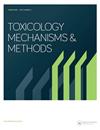The role of NF-κB and AhR transcription factors in lead-induced lung toxicity in human lung cancer A549 cells
IF 2.8
4区 医学
Q2 TOXICOLOGY
引用次数: 18
Abstract
Abstract Lead (Pb) is recognized as the first heavy metal of the top six toxic air pollutants threatening human health and the second hazardous substance. Pb exposure is associated with lung impairment and high incidences of lung cancer. Nuclear factor kappa B (NF-κB) and aryl hydrocarbon receptor (AhR) signaling pathways are known to be expressed and play an important role in the lung. However, the link between Pb lung toxicity and NF-κB and/or AhR pathways remains unclear. This study was established to explore the role of NF-κB and AhR modulation in Pb-induced lung toxicity in human lung cancer A549 cells. In the current study, treatment of A549 cells with Pb significantly induced cell apoptosis as evidenced by increasing a) the percentage of cells underwent apoptosis determined by flow cytometry and b) p53 mRNA level. Pb treatment induced oxidative stress by a) increasing the formation of reactive oxygen species and b) decreasing GSTA1 mRNA levels. The toxic effects of Pb on the lung was associated with significant increases in NF-κB and AhR levels which was accompanied with increases in downstream targets genes, iNOS and CYP1A1, respectively. Inhibition of NF-κB or AhR either chemically using resveratrol or genetically using small interfering RNA (siRNA) significantly rescued A549 cells from Pb-mediated lung toxicity. The results clearly indicate that Pb-mediated lung toxicities are NF-κB and AhR-dependent mechanism.NF-κB和AhR转录因子在铅致人肺癌A549细胞肺毒性中的作用
摘要铅(Pb)是危害人类健康的六大有毒空气污染物中的第一种重金属,也是第二种有害物质。铅暴露与肺损伤和癌症的高发病率有关。已知核因子κB(NF-κB)和芳烃受体(AhR)信号通路在肺中表达并发挥重要作用。然而,铅肺毒性与NF-κB和/或AhR途径之间的联系尚不清楚。本研究旨在探讨NF-κB和AhR调节在人肺癌癌症A549细胞铅诱导的肺毒性中的作用。在目前的研究中,用Pb处理A549细胞显著诱导细胞凋亡,如增加a)通过流式细胞术测定的细胞凋亡百分比和b)p53 mRNA水平所证明的。Pb处理通过a)增加活性氧的形成和b)降低GSTA1mRNA水平来诱导氧化应激。铅对肺部的毒性作用与NF-κB和AhR水平的显著增加有关,这分别伴随着下游靶基因iNOS和CYP1A1的增加。用白藜芦醇化学或用小干扰RNA(siRNA)基因抑制NF-κB或AhR可显著挽救A549细胞免于铅介导的肺毒性。结果清楚地表明,Pb介导的肺毒性是NF-κB和AhR依赖性机制。
本文章由计算机程序翻译,如有差异,请以英文原文为准。
求助全文
约1分钟内获得全文
求助全文
来源期刊

Toxicology Mechanisms and Methods
TOXICOLOGY-
自引率
3.10%
发文量
66
期刊介绍:
Toxicology Mechanisms and Methods is a peer-reviewed journal whose aim is twofold. Firstly, the journal contains original research on subjects dealing with the mechanisms by which foreign chemicals cause toxic tissue injury. Chemical substances of interest include industrial compounds, environmental pollutants, hazardous wastes, drugs, pesticides, and chemical warfare agents. The scope of the journal spans from molecular and cellular mechanisms of action to the consideration of mechanistic evidence in establishing regulatory policy.
Secondly, the journal addresses aspects of the development, validation, and application of new and existing laboratory methods, techniques, and equipment. A variety of research methods are discussed, including:
In vivo studies with standard and alternative species
In vitro studies and alternative methodologies
Molecular, biochemical, and cellular techniques
Pharmacokinetics and pharmacodynamics
Mathematical modeling and computer programs
Forensic analyses
Risk assessment
Data collection and analysis.
 求助内容:
求助内容: 应助结果提醒方式:
应助结果提醒方式:


